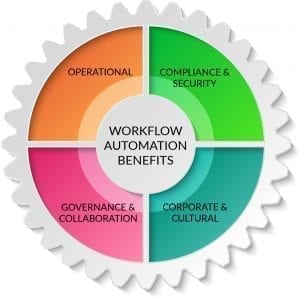Learn the 4 Big Benefit Buckets of Legal Ops Automation
There are no less than four major areas where legal workflow automation can revolutionize Legal Ops. Let’s explore them, in this extract from our in-depth new ebook.
Legal automation creates a broad range of benefits
Workflow automation can bring huge benefits to any enterprise. But it’s uniquely advantageous for Legal Operations departments.
How? By helping them address a host of challenges:
- Corporate mandates to deliver more legal services more quickly, but while constraining (or even cutting) costs.
- The burdens of corporate, regulatory and statutory compliance, with penalties for mistakes and delays.
- The dangers of repetitive, high-frequency manual processes with multiple steps, which engender errors.
- The demand for transparency, centralization and collaboration, particularly as an organization grows.

Automating Legal Ops workflows doesn’t merely help overcome all of these challenges. By doing so, it spins off a whole range of benefits.
To make sense of all the rewards an SaaS-based legal workflow automation solution can supply to Legal Ops and the corporation as a whole, let’s separate them into four different “benefit buckets.”
We’ve shown those areas in the graphic at right. But when you drill down into the details, the list gets extensive – and impressive.
Operational Benefits:
- Quick adoption drives quick results, especially with browser-based SaaS platforms with intuitive UX, drag-and-drop design tools and short learning curves.
- Workflow speed and efficiency increases now that users always follow a predefined work path.
- Significantly lowered operational costs owing to savings in time, labor, even materials.
- Immediate WFA ROI is common, as cost saving equal quick payback for a platform investment.
- Scalability, since if a workflow correctly automated once, it can run a thousand times with just as must effectiveness.
- Verifiable execution of each process, with near-complete transparency into any workflow.
- Higher completion rates (process success) for all workflows.
- Accurate form and document completion, thanks to use of dynamic forms and document templates with embedded intelligence to guide accurate completion and submission.
- Process error elimination, owing to standardization and the automation of repetitive (and error-prone) tasks such as routing, archiving and notifications.
- More precise data capture, since the most accurate source is often the individual served by the workflow or the employee closest to the process, whose performance is judged by its outcome; giving them self-service access to the workflow drives input accuracy.
- Self-service productivity boosts. By using automated notifications to remove the tasks of chasing down colleagues to provide approvals or information, major productivity upticks happen.
- Minimization of costly attorney engagement with mundane/repetitive tasks.
- End-to-end process support, as we replace the limited process knowledge each individual participant along the chain may (or may not!) possess.
- Frictionless integration at lower cost as a best-in-class SaaS workflow automation platform will work smoothly with legacy systems and third-party products, eliminating the need for costly rip-and-replace installation or IT and developer consultation.
- Higher-quality work. A 2006 review of healthcare providers who had installed workflow automation found that not only were there expected benefits like time savings, reductions in staff stress and improvements in morale, but the actual quality of care being given to patients had improved.

Compliance & Security Benefits:
- Compliance rates increase and liabilities are minimized. One simple example: an automated workflow won’t forget a deadline, so late penalties can be reduced or eliminated.
- Improved auditing at a level sufficient for evidentiary purposes.
- Clarity, visibility and reportability is ensured for every workflow.
- Guaranteed archiving and disaster protection as workflows and assets are automatically stored in the Cloud (or on-premise or in hybrid configurations).
- Enhanced security, if your WFA platform is equipped to meet top-tier security certification standards and provide best-in-class e-signature integration, video identity confirmation, and even blockchain-based workflow audit trail storage.
Governance & Collaboration Benefits:
- Improved governance, as centralization and process standardization now work hand-in-hand, providing a framework for Legal Ops control and tracking and a cohesive risk management framework.
- Core data alignment from a single source of truth, making it far easier for employees anywhere to locate, manage, share and report on casework.
- Mobile and remote accessibility improves productivity and engagement.
- Augmented collaboration, especially if a Legal WFA platform features flexible collaboration tools and participant invitation/notification features.
Legal Ops teams adopting WFA are more responsive to corporate needs, and may even be viewed as positive “change agents” for driving process improvements elsewhere in the organization.
Corporate & Cultural Benefits:
All the benefits listed above drive other meaningful “macro” benefits for Legal Ops:
- Improved corporate and stakeholder services, thanks to increased agility, responsiveness, accuracy, security and other benefits.
- Stronger corporate client ties and partnership: Legal Ops can grow stronger ties with internal clientele once repetitive tasks have been automated, removing burdens on everyone involved.
- Elevated reputation within the enterprise: Legal Ops teams adopting WFA are more responsive to corporate needs, and may even be viewed as positive “change agents” for driving process improvements elsewhere in the organization.
- Positive morale: Legal firms that have deployed workflow automation have seen employees, especially Millennials, acquire a more positive view of the organization; younger attorneys feel they’re being supported by their firms and made part of a collaborative team.
- Job creation: Legal Ops departments have moved tech-heavy jobs in-house to accelerate development and deployment of customized tech tools to nurture better collaborations with clients, employees and end users.
A guide for proactive Legal Ops technology planning
With so many potential benefits, it’s vital to take the step into Legal Ops technologies like workflow automation. More practices and corporations than ever are doing exactly that.
What’s just as important? Making the right choices in terms of preparing for legal WFA adoption and choosing the right legal workflow automation platform. We’ve covered every facet of Legal Ops workflow automation adoption in our comprehensive new ebook, Why Your Legal Ops Needs a Leading-Edge Workflow Automation Platform.
Just use the link below to get your own free copy. It’s an invaluable resource for any legal services provider CIO, CISO or Legal Ops technology leader as they make their plan for digital transformation.




